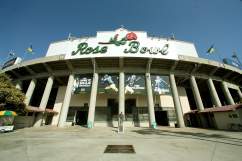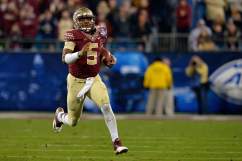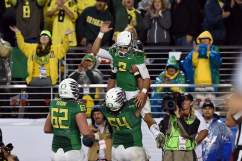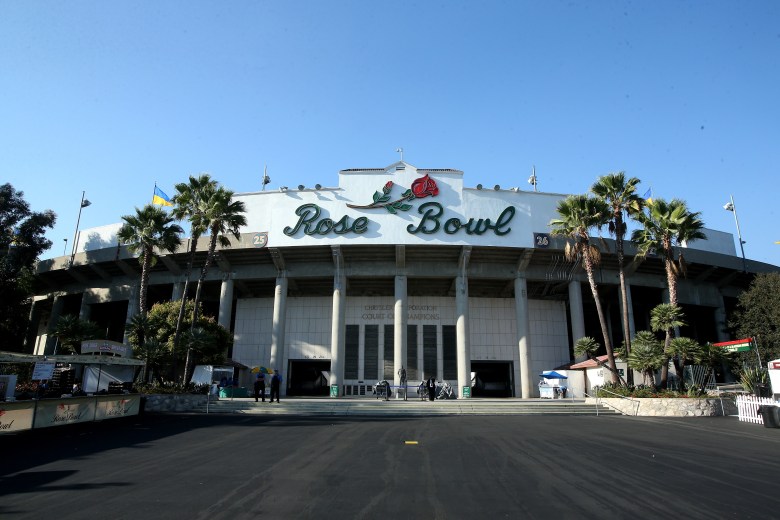
(Getty)
Nicknamed “The Granddaddy of Them All” because it is the oldest bowl game in college football, the Rose Bowl was first played in 1902. Since 1916, it has been played annually. It has been the most attended college football game since 1945.
It’s part of the Pasadena Tournament of Roses Association, which, since 1980, has held the New Year’s Day Rose Parade.
This year, the Rose Bowl, which is played in the Rose Bowl in Pasadena, Calif., will feature the second-ranked Florida State Seminoles and the third-ranked Oregon Ducks. This will also be the third meeting all-time between two Heisman winners with this match up featuring Jameis Winston and Marcus Mariota.
History
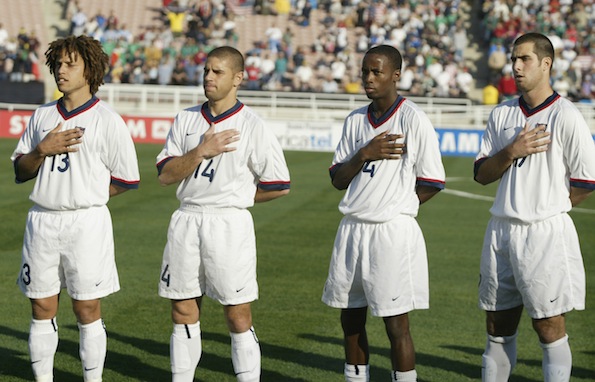
Cobi Jones #13 stands with Chris Armas #14, DaMarcus Beasley and Carlos Bocanegra #17 of the USA for the National Anthem before the Gold Cup match against Cuba on January 21, 2002. (Getty Images)
The first football game played at Rose Bowl, then called Tournament Park, was played on New Year’s Day of 1902. After that, until 1916, the stadium was used for chariot, ostrich and elephant-camel races. In 1916, college football came back to the stadium and has been there ever since. Below is a brief history of the stadium, from the Rose Bowl website.
In 1920, the stadium was declared unsafe for the growing crowd by city officials. Ten-year box seats were sold for $100 to help raise funds for the eventual $272,198 reconstruction to the stadium in 1922, which now had a capacity of 57,000. The new stadium was designed by Myron Hunt and was named “Rose Bowl” in 1923.
The first game played at the Rose Bowl was delayed by over an hour due to Penn State’s team being stuck in traffic. The Nittany Lions eventually went on to lose the game, 14-2, to USC.
The following year featured the Rose Bowl’s first tie, a 14-14 final between Washington and Navy.
Nineteen thousand seats were added to the stadium in 1928, and in 1931 some of the wooden stands were removed and replaced with reinforced concrete seating. This change allowed for an additional 10,000 seats, bringing the capacity up to 83,000. By 1969, the remaining wooden benches were replaced with aluminum seating.
In 1932, the Rose Parade was broadcast via short-wave radio for the first time ever. This broadcast was heard around the world. This was also the year that cycling events of the Summer Olympics, Games of the X Olympiad, were held at the Rose Bowl. The United States finished first in the Games with 103 medals.
The 1942 Rose Parade was canceled and the game was moved to Duke Stadium in Durham, North Carolina because of World War II. However, the parade was held, and the game returned the following year.
In 1950, seating in the stadium was again increased, bringing the capacity up to 100,983. This allowed the football game to be the first bowl game with an attendance over 100,000.
The 1962 game was the first college game to be broadcast nationally in color, and in 1968 it was shown internationally via satellite beaming. The game wasn’t broadcast in Spanish until 1988.
The first Super Bowl held at the Rose Bowl was Super Bowl XI, which was played in 1977 and featured the Oakland Raiders and Minnesota Vikings. Oakland went on to win, 32-14. The attendance at this game was 103,438.
In 1980, Super Bowl XIV, also held at the Rose Bowl, broke the record for attendance at a Super Bowl with 103,985 spectators. In this game, The Pittsburgh Steelers defeated the Los Angeles Rams, 31-19.
The Rose Bowl became the official stadium of the University of California at Los Angeles in 1982. This was also the year that an eight-year project to add earthquake reinforcements to the stadium was started. During this reconstruction, the locker rooms were remodeled, the parking lot was updated and a new sound system was installed.
Super Bowl XVII, which was played in 1983 between the Washington Redskins and Miami Dolphins. Washington won, 27-17, in front of 103,667 spectators.
The 1984 Summer Olympics, the XXIII Olympiad, was the first profitable Olympic games. The Rose Bowl was host to the gold medal soccer game between France and Brazil. France won the match, 2-0. The event was attended by 101,799 people.
The New York Giants defeated the Denver Broncos, 39-20, in Super Bowl XXI. The game, played in 1987 at the Rose Bowl, had 101,063 spectators.
In 1992, the stadium added almost 1,000 seats in the Executive and Club Suites for news media and spectators. The renovations cost $11.5 million and increased the capacity from 330 to 1,200. The following year, more seats were added to the stadium and the capacity grew to 104,594.
In 1993, 101,000 of those seats were filled by spectators of Super Bowl XXVII, in which the Dallas Cowboys beat the Buffalo Bills, 52-17.
World Cup USA donated $2 million for renovations to the stadium that increased the field to 224 feet wide by 345 feet long, and permanent ramps for disabled spectators were installed. This change was in preparation for the 1994 World Cup. However, the capacity was decreased to 100,184. There were eight Cup games played at the Rose Bowl, with a total attendance of 715,826, averaging 89,478 per game.
In 1996, the LA Galaxy of the MLS continued the use of the new soccer field when they selected the Rose Bowl as their home stadium. This was also the year of a $21.5 million renovation to the stadium that updated the sound system, scoreboards, video board, restrooms and elevators, that now had field access.
The Rose Bowl joined the Bowl alliance this year, meaning that the stadium would host the Pac-10 and Big Ten Championships every season as well as the National Championship game every four years from 2002 on.
The following year, 1997, featured the capacity decreasing to 98,636.
In 1999, the stadium gained it’s first official sponsor, AT&T.
The stadium was again renovated in 2011. The $152 million renovation was the largest investment in the structure and was projected to be finished by January 2014 in time for the 100th Rose Bowl Game and BCS National Championship Game.
Tradition

The most known tradition of the Rose Bowl is that the game is played on New Year’s Day — except when it isn’t. If New Year’s falls on a Sunday, the game is then moved to Monday, January 2. This has happened 13 times in Rose Bowl history. On two other occasions, January 3, 2002, and January 4, 2006, the Rose Bowl was host to the BCS National Championship Game. Since these were not the Rose Bowl Game, they were not played on New Year’s Day.
In addition to the college football game, there is the Rose Parade. According to the parade’s website, about 80,000 hours of manpower from 935 people go into preparation for the event. These people are members of the non-profit Tournament of Roses Association. The members are assigned to one of 31 committees that have various responsibilities that range from selecting parade participants to helping spectators the day of the parade to working with the media people covering the game to giving presentations to community groups. These volunteers are called “White Suiters,” according to the website, because of the distinct white suits they wear during the parade.
The parade’s website describes it as being an event unique to the United States.
It’s a celebration more than a century old – a festival of flowers, music and sports unequaled anywhere else in the world. It’s America’s New Year Celebration, a greeting to the world on the first day of the year, and a salute to the community spirit and love of pageantry that have thrived in Pasadena for more than 100 years.
The parade had a 51-year record of good weather that ended in 2006, when the Pasadena area was hit by five inches of rain. However, the parade went on as planned.
When it comes to Rose Bowl team traditions, the two that will be featured in the game take part in the Beef Bowl, an informal eating contest. While changes in the emphasis of nutrition have modified the eating, the Beef Bowl is still held annually at Lawry’s in Beverly Hills, according to a New York Times article that covered last year’s event.
“But something profound has changed in recent years. Nutrition is now emphasized as an important component in athletic performance, and players are as likely to count calories as the pounds of meat they can eat.
Lawry’s has contributed to this change by limiting the amount of prime rib it serves each player: a 16-ounce cut followed by a 12-ounce second helping. It no longer publicizes how much each team eats, although the team and individual marks are believed to be held by Purdue in 2001 (734 pounds) and Michigan offensive lineman Ed Muranksy in 1978 (8 pounds).
Richard R. Frank, the president and chief executive of Lawry’s, cautioned both teams during their visits — Friday night for Michigan State and Saturday night for Stanford — that the Beef Bowl was no longer a competition.”
However, the connection between the Beef Bowl and Rose Bowl is completely informal.
“It’s based on trust,” Frank said. “It works for us; it works for them. Why mess it up?” — From the NYT article.
Past Rose Bowl Games
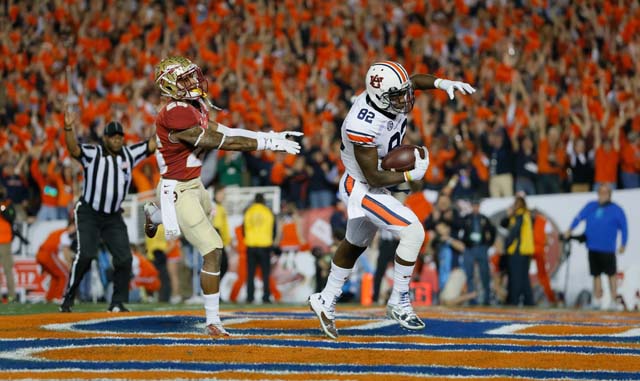
1902 – Michigan, 49, Stanford, 0
1916 – Washington State, 14, Brown, 0
1917 – Oregon, 14, Pennsylvania, 0
1918 – Mare Island – USMC, 19, Camp Lewis – US Army, 7
1919 – Great Lakes – US Navy, 17, Mare Island – USMC, 0
1920 – Harvard, 7, Oregon, 6
1921 – California, 28, Ohio State, 0
1922 – California, 0, Washington & Jefferson, 0
1923 – USC, 14, Penn State, 3
1924 – Washington 14, Navy 14
1925 – Notre Dame, 27, Stanford, 10
1926 – Alabama, 20, Washington, 19
1927 – Stanford, 7, Alabama, 7
1928 – Stanford, 7, Pittsburgh, 6
1929 – Georgia Tech, 8, California, 7
1930 – USC, 47, Pittsburgh, 14
1931 – Alabama, 24, Washington, 0
1932 – USC, 21, Tulane, 12
1933 – USC, 35, Pittsburgh, 0
1934 – Columbia, 7, Stanford, 0
1935 – Alabama, 29, Stanford, 13
1936 – Stanford, 7, SMU, 0
1937 – Pittsburgh, 21, Washington, 0
1938 – California, 13,, Alabama, 0
1939 – USC, 7, Duke, 3
1940 – USC, 14, Tennessee, 0
1941 – Stanford, 21, Nebraska, 13
1942 – Oregon State, 20, Duke, 16
1943 – Georgia, 9, UCLA, 0
1944 – USC, 29, Washington, 0
1945 – USC, 25, Tennessee, 0
1946 – Alabama, 34, USC, 14
1947 – Illinois, 45, UCLA, 14
1948 – Michigan, 49, USC, 0
1949 – Northwestern, 20, California, 14
1950 – Ohio State, 17, California, 14
1951 – Michigan, 14, California, 6
1952 – Illinois, 40, Stanford, 7
1953 – USC, 7, Wisconsin, 0
1954 – Michigan State, 28, UCLA, 20
1955 – Ohio State, 20, USC, 7
1956 – Michigan State, 17, UCLA, 14
1957 – Iowa, 35, Oregon, 19
1958 – Ohio State, 10, Oregon, 7
1959 – Iowa, 38, California, 12
1960 – Washington, 44, Wisconsin, 8
1961 – Washington, 17, Minnesota, 7
1962 – Minnesota, 21, UCLA, 3
1963 – USC, 42, Wisconsin, 37
1964 – Illinois, 17, Washington, 7
1965 – Michigan, 34, Oregon State, 7
1966 – UCLA, 14, Michigan State, 12
1967 – Purdue, 14, USC, 13
1968 – USC, 14, Indiana, 3
1969 – Ohio State, 27, USC, 16
1970 – USC, 10, Michigan, 3
1971 – Stanford, 27, Ohio State, 17
1972 – Stanford, 13, Michigan, 12
1973 – USC, 42, Ohio State, 17
1974 – Ohio State, 42, USC, 21
1975 – USC, 18, Ohio State, 17
1976 – UCLA, 23, Ohio State, 10
1977 – USC, 14, Michigan, 6
1978 – Washington, 27, Michigan, 20
1979 – USC, 17, Michigan, 10
1980 – USC, 17, Ohio Sate, 16
1981 – Michigan, 23, Washington, 6
1982 – Washington, 28, Iowa, 0
1983 – UCLA, 24, Michigan, 14
1984 – UCLA, 45, Illinois, 9
1985 – USC, 20, Ohio State, 17
1986 – UCLA, 45, Iowa, 28
1987 – Arizona State, 22, Michigan, 15
1988 – Michigan State, 20, USC, 17
1989 – Michigan, 22, USC, 14
1990 – USC, 17, Michigan, 10
1991 – Washington, 46, Iowa, 34
1992 – Washington, 34, Michigan, 14
1993 – Michigan, 38, Washington, 31
1994 – Wisconsin, 21, UCLA, 16
1995 – Penn State, 38, Oregon, 20
1996 – USC, 41, Northwestern, 32
1997 – Ohio State, 20, Arizona, 17
1998 – Michigan, 21, Washington State, 16
1999 – Wisconsin, 38, UCLA, 31
2000 – Wisconsin, 17, Stanford, 9
2001 – Washington, 34, Purdue, 24
2002 – Miami (FL), 37, Nebraska, 14
2003 – Oklahoma, 34, Washington State, 14
2004 – USC, 28, Michigan, 14
2005 – Texas, 38, Michigan, 37
2006 – Texas, 41, USC, 38
2007 – USC, 32, Michigan, 18
2008 – USC, 49, Illinois, 17
2009 – USC, 38, Penn State, 24
2010 – Ohio State, 26, Oregon, 17
2011 – TCU, 21, Wisconsin 19
2012 – Oregon, 45, Wisconsin, 38
2013 – Stanford, 20, Wisconsin, 14
2014 – Michigan State, 24, Stanford, 20
